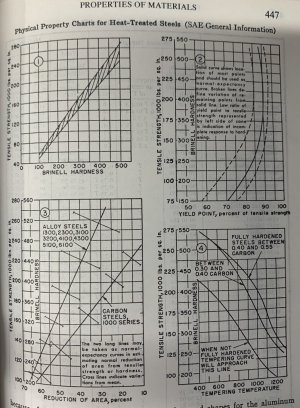- Joined
- May 3, 2020
- Messages
- 229
The problem you're up against is quenching of the welded area due to the heat-sink effect of the adjoining material. One source [1] says for 0.20--0.40% carbon steels, no preheating is needed unless plate is over 0.500" thick. But over 0.40% needs preheat, regardless of thickness. I would pre-heat to 350--400 oF,
You may not need post heat. Unless you're machining the welded area, it probably isn't required.
If you do post heat, remember that the purpose is to draw a temper in the hardest part of the weld So I think you'll need a much higher temperature... Look at the graph below, in the lower right quadrant [2]. Using Rockwell C of 30 (commercial heat treat) as a reference, that is Brinell BHN of 286. I would use the full hard line because that's the worst-case scenario around the weld. In either case, you'll need 800 oF or more to make much of a difference. HOWEVER it probably is not needed unless you are going to machine those welds. If you post heat, you're only tempering a very small part of the weld, so it might be OK to heat the weldment and let it cool in still air. The mass of the adjoining parts should slow the cooling in the weld metal. Personally, I would turn the oven off and leave it to cool within. If I couldn't fit the weldment in the oven, I would put it on round bar to minimize contact with the welding table, heat with MAPP gas, and then throw a welding blanket over the whole works.

1. Metals and How to Weld Them by T B Jefferson, G Woods, pub James F Lincoln Arc Welding Foundation
2. Machinery's Handbook 24
You may not need post heat. Unless you're machining the welded area, it probably isn't required.
If you do post heat, remember that the purpose is to draw a temper in the hardest part of the weld So I think you'll need a much higher temperature... Look at the graph below, in the lower right quadrant [2]. Using Rockwell C of 30 (commercial heat treat) as a reference, that is Brinell BHN of 286. I would use the full hard line because that's the worst-case scenario around the weld. In either case, you'll need 800 oF or more to make much of a difference. HOWEVER it probably is not needed unless you are going to machine those welds. If you post heat, you're only tempering a very small part of the weld, so it might be OK to heat the weldment and let it cool in still air. The mass of the adjoining parts should slow the cooling in the weld metal. Personally, I would turn the oven off and leave it to cool within. If I couldn't fit the weldment in the oven, I would put it on round bar to minimize contact with the welding table, heat with MAPP gas, and then throw a welding blanket over the whole works.

1. Metals and How to Weld Them by T B Jefferson, G Woods, pub James F Lincoln Arc Welding Foundation
2. Machinery's Handbook 24

